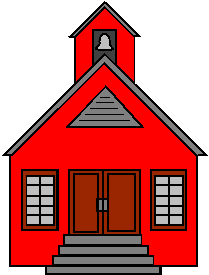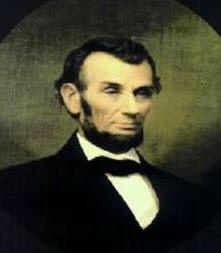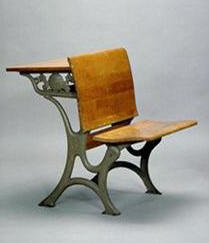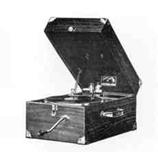Hanover
#4
By
Dan Zoll
It
was in the fall of 1938 when this scared little boy walked the quarter mile over
the Highway 13 to the
Hanover
#4 grade school. It was the grade
school that all of our family attended for part of their schooling.
We were fortunate in that the school was only about a quarter mile from
where we lived.
 Hanover
No. 4 was a country school with the 8 grades contained in one room.
At the time I attended Hanover No. 4, there were probably close to twenty
students enrolled. Due to some fluke
of nature, the population of the school consisted of almost all boys.
Kathryn and Mark Kay were the only girls in the school in my later years
at No. 4. I believe there were more
girls in the earlier years but the names escape me for the moment. Hanover
No. 4 was a country school with the 8 grades contained in one room.
At the time I attended Hanover No. 4, there were probably close to twenty
students enrolled. Due to some fluke
of nature, the population of the school consisted of almost all boys.
Kathryn and Mark Kay were the only girls in the school in my later years
at No. 4. I believe there were more
girls in the earlier years but the names escape me for the moment.
Hanover
No. 4 was located on a square patch of land on top of a hill just north of our
house. It was bounded on the south
side by a county road, on the west side by the Emmet Wards farm.
A row of tall evergreen trees separated the school from the Wards house
and farm buildings. The north side
was open and had a great view of the valley below including the church and
parish. The fence on the North side
had a grapevine growing on it; in the fall we would treat ourselves to some tart
grapes. On the East side was a state highway, at that time called Highway 13.
The highway was cut down into the hill so that from the schoolyard you
looked down on the highway. Across
the cut and the road on the east side was the John McCormick farm.
The school is gone now, as are most all country schools.
The Emmet Ward farm is gone now too.
Mary McCormick still lives in the house on the McCormick farm.
Rose
was the teacher for our final year at
Hanover
#4, (she later married a cousin of mine). I
was in the seventh grade and my younger brother was in the fifth; the following
year we went to St. Pats for the sixth and eighth grade.
It was Rose’s first year as a teacher.
She indicated that she probably learned more than her students.
The way I figured it, she was 17 at the time.
In those days a teachers certificate was much easier to get than it is
today. In her first year there were
21 students; 19 boys and 2 girls. There
was one first grader, seven second graders, two in the third grade, seven in the
fifth grade and four in the seventh grade.
The School Room
The one room
Hanover
# 4 school actually consists of three rooms; the main class room, the entry
room and the basement. To enter the
school, you must climb the concrete steps outside the entry.
You open the door and you find you in a good sized room, about 10’ by
10’. On your left is the doorway
into the basement. The stairway into
the basement was covered. The top
side of the covered stairwell formed a shelf on your left about three to four
feet high. That’s where we used to
store our lunches until recess or noon.
On
your right are hooks in the wall for hanging winter coats, hats and scarves.
In winter the walls of the entryway would be covered on three sides by
winter coats. The walls at floor
level would be haphazardly lined with overshoes strewn about.
The
basement was a light and cheerful basement; there were six window along the
basement wall above ground. It is
easy to forget that we didn’t have electricity in those days.
The only lighting in the basement was natural lighting coming in the
windows. The basement contained a
big furnace and a supply of wood; and in later years, coal.
To enter the main class room, you again went up a short flight of stairs.
It was a very typical country school classroom.
The far wall as you entered the room was a wall-to-wall slate blackboard.
Above the blackboard was a roll-up map case, in which you could pull down
one of several maps; one of the world, of North America, South America, the
United States and Iowa. The maps
were an integral part of our geography lessons.
On Fridays we used to have map games where the teacher would pull down a
map and read off a name of a capital and the first student that called out the
state or country would win. This
would go on for a whole class period. Later
we got into cities rather than capitals
 |
Above the map case and off to right was a copy of
the famous uncompleted portrait of George Washington by Gilbert Stuart.
For balance the portrait of Abe Lincoln was hung on the left.
I don’t remember who painted that one.
|
 |
|
|
|
 The teachers desk was in the front of the room a
few feet from the blackboard. Just
in front of the teachers desk was a long bench.
This bench was used to conduct classes.
For example, when it was time for the 5th grade arithmetic
class or spelling class to convene, the teacher would call the class up to the
bench and quiz them on the assignment or send them to the board for math
problems or spelling words. The rest
of the school would be busy doing their assignments, day-dreaming or learning
next years words and problems. The teachers desk was in the front of the room a
few feet from the blackboard. Just
in front of the teachers desk was a long bench.
This bench was used to conduct classes.
For example, when it was time for the 5th grade arithmetic
class or spelling class to convene, the teacher would call the class up to the
bench and quiz them on the assignment or send them to the board for math
problems or spelling words. The rest
of the school would be busy doing their assignments, day-dreaming or learning
next years words and problems.
The rest of the room was taken up four rows of desks.
There were two rows on the left side of the room and two rows on the
right side. The desks were much like
that shown here. These desks were
fastened to 1 x 4s so all the desks in a row were attached together.
The desks in the front of each row were smaller for the lower grades.
The rear desks were larger for the bigger kids.
The center of the room was open. There
was a big hot air grate where heat from the furnace would rise to heat the room.
The grate was about four feet by four feet. There were three big windows
on the East and West side of the school. They
gave plenty of light on most days. On
those cloudy winter days, though, I am sure there was not a lot illumination,
but it didn’t bother the kids.
 Other furnishing in the room included a small table with a portable
Victrolia record player near the front window on the left side.
This record player was one of the wind-up-with-a-crank type record
player. It was used for our
music/singing class. We would sing
lots of old Steven Foster favorites like, Camptown Races, Old Folks at Home, My Old Kentucky Home, Jeanie with the
Light Brown Hair, and Old Black Joe.
Other furnishing in the room included a small table with a portable
Victrolia record player near the front window on the left side.
This record player was one of the wind-up-with-a-crank type record
player. It was used for our
music/singing class. We would sing
lots of old Steven Foster favorites like, Camptown Races, Old Folks at Home, My Old Kentucky Home, Jeanie with the
Light Brown Hair, and Old Black Joe.
In the back of the room was a table upon
which sat the water crock. It was a
white porcelain crock with a push button faucet near the bottom.
When you wanted a drink, you would get your cup (each student had his/her
own cup) and push the button and fill the cup – (after you got permission from
the teacher).
Most of the kids had collapsible cups made out of tapered rings of tin
nestled together. When the water jug
was near empty, some two kids would be assigned to take the pail over to the
McCormick farm to get some water. The older boys were usually assigned to this
chore because the pail, once full, was heavy.
The pail was a long, somewhat thin, pail, often used for milk.
Again it seemed that the fellows assigned to that chore always seemed to
have trouble with the windmill because it always seem to take over a half hour
to get the water.
The Flag Pole Duty
There was a flag pole on the eastern edge of the schoolyard.
One of the choice chores assigned to
Hanover
#4 students was putting up the flag and taking it down every day.
After school started at 8:00 each morning two students would get the flag
and go outside for the flag raising. If
the kids chosen were of the adventurous or brazen type, they would not be back
for 10 to 15 minutes. When asked by
the teacher “What took so long?”,; they would reply, “The rope was
tangled,” or “The pulley was stuck” or “We didn’t notice at first, but
we put it up upside down and had to take it down and put up right.”
There were a thousand excuses for taking a little more time than
they should. It never took that long
to take it down because the lowering of the flag was after school was dismissed
and the school kids wanted to be on their way home.
The Chalk Eraser Duty
Once a week, usually on Friday, someone in the school was chosen to clean
the chalk erasers. There were four
or five erasers associated with the slate blackboard.
By the end of the week, they were quite chalked up.
The teacher would choose someone to take the erasers outside and beat
them together, one in each hand, like clapping, to get the chalk out of them.
Another technique was to beat each eraser against the concrete steps into
the school. That would leave chalk
marks all over the steps, which the teacher didn’t like but it was a faster
technique than beating them together. It
would depend upon the weather which technique was employed; if the weather was
nice out and we were not in any hurry to get back inside, we would employ the
“beat together” method. If it
was the dead of winter, we would beat them on the concrete a couple of times and
get back inside.
The Furnace and the Grate
As mentioned above, the school was heated by a big wood furnace that was
in the basement of the school. It
operated on a principle of hot air rising. There
was a big grate, in the middle of the school room.
Warm air would rise from the furnace through the grate and fill the
school room, at least that was the theory. You
must remember that the school operated without the benefit of electricity.
There was no blower to spread the heat around.
So it was warm or even hot near the furnace grate and cold on the outer
rows of desks near the windows. The
windows did have storm window installed in winter but there was not much
insulation in those old school walls. The
teacher had the job of getting to school early each day during winter and
starting the fire in the furnace.
After walking to school on those cold winter days, the kids would rush to
stand on that grate. After more kids
arrived, there would be some pushing and shoving to get a prime spot on the
grate. There were always lots of
claims; “I was here first” and counterclaims “You have had it long enough
now, let someone else have a chance.”
My older brother, Harold remembers that the furnace was inside some kind
of jacket or enclosure. And while
the girls were scrambling for a prime spot on the grate upstairs in the
classroom, some of the wise little guys would go down into the basement, and
would open the enclosure door, look up and sing out, "I see
London
, I see
France
, I see someone's under pants". All
the girls would scream and jump off the grate.
My older sister, Ann remembers the time she stood on the furnace grate
when her coat started to smoke but she got off fast enough that it didn’t
catch fire. Mother had just the day
before cleaned it by washing it in naphthalene in the garage.
T’was a miracle that we didn't all catch on fire.
After recess, you would put your wet gloves and mittens on the grate to
dry out before the long walk home.
Ann
has two other vivid memories. One
day the old house in the valley just north east of then Gallaghers house caught
fire. We of course all watched from
the school windows--it was winter. Lots of commotion.
Mary Ahern was the teacher then. At
close of school every day she took out a notebook, called each student by name
and asked if each "whispered" that day.
On the day of the fire each answered 'No".
She slammed the book shut and angrily reminded us that we all of course
did.
Schoolyard Games
Before getting into the games we played as students in
Hanover
#4, I want to include in this paper a segment “Recess Games of the Old
Country School” by Tom Isern. He
has captured very nicely the effect and impact of the one room school.
“There has been little informed post-mortem
comment on the relative quality of the educational experience provided by the
town schools as compared to that offered by the country schools.
Modern school administrators, in line with their professional training,
have assumed the superiority of their schools and espoused a gospel of progress.
The only serious historian to examine the question, Wayne Fuller (in The
Old Country School: The Story of
Rural Education in the Middle West), has weighed the virtues and defects of the
old system and concluded that it worked rather well---educating the children,
providing a locus of community, and breeding pure democracy.
Perhaps, Fuller writes, more has been lost than gained.”
“Among the losses, too, are the traditional games
played during recess at the country schools.
These games stood in contrast to those played today in the town schools,
which largely represent homogenized, urbanized, supervised American popular
culture. The country school recess
games represented rural folklife.”
“The contrast is both apparent and profound.
Children in town schools today associate and play only with children
their own age. At recess teachers
supervise pupils playing the organized sports common to American popular
culture--soccer, softball, and so on. The
schools have spacious playgrounds and ample equipment.
Children in the old country schools all played together, grades one to
eight. Games had to be so designed
that all sizes of pupils could take part without dismembering one another.
Teachers rarely supervised play; most had work to do during recess, and
some younger ones joined in the games, but in either case there was no referee.
The players had to be self-governing.”
“Equipment was scarce.
Children had to do without or make use of junk (sticks, rocks, tin cans)
and fixed objects (fences, trees, the schoolhouse) in their games.
Instead of existing in an illusory world where everyone was the same age,
pupils in the country schools became accustomed to competition and cooperation
with comrades of various ages. In
settling their own disputes they learned basic fairness--not that fairness
always ruled, but they recognized it even when it was violated.
They learned to improvise in the absence of resources.”
“Moreover, the games played were different in
basic ways from sports such as soccer or softball.
In such sport contests there are two teams, and one defeats the other.
In most of the country school games, the winning parties absorbed the
losing ones into their own team rather than defeating them.
Thus the games in the country schools informally taught ideals of
community and citizenship profoundly different from those of the town
schools.”
“It is probably impossible to reestablish this
fusion of recreation with democracy for todays pupils, but if they are to
understand the cultural influences of earlier generations, it is desirable at
least to recreate it for study. Presented
with these games, children still play them with enthusiasm.
Unfortunately, few know how to play them without initial help.
Hence this bulletin, designed to encourage perpetuation of traditional
country school recess games as living documents of cultural history.”
Each generation passes through childhood in their own way and with their
own traditions and customs. But
children are much the same everywhere, the world over.
One of the objectives of this paper is to recall some of the customs and
traditions existing in my generation at Hanover No. 4, North of Waukon.
As
I recall, we used to have two recesses and a lunch hour break as a part of our
school day. We had a number of games
that we used to play at recess or at noon. We
used to play Prisoners Base, Ante, Ante Over, and in the winter Fox and Goose
and King of the Mountain. The one I
want to describe now was called Prisoners Base.
Prisoners Base
The game called Prisoners Base may have had Indian origins or gypsy
origins and was also called Dare Base and Prison Bars.
The first step in establishing the game was for the two biggest studs in
the schoolyard to choose up sides. The
principal criterion for being selected was foot speed, quickness and a daring
attitude. It also helps to be pals
with one of the schoolyard studs. The
teams would line up along two parallel lines, one team on one line and the other
team on the other line. The lines
were about 60 to 100 feet apart. Individuals
from each team would make a daring excursions from its line or home base which
was a "safe" area, over toward the enemies line or base.
When a two opposing raiders meet in midfield, the one who left base last
is able to "capture" the other. Once
captured, the prisoner must remain touching the opponents base until he is
touched by a teammate. If more
prisoners were taken, the last prisoner must keep one foot on the opponents base
while holding hand with the previous prisoner.
The prisoners form a line stretching out toward their own base.
The more prisoners in the line, the easier it was to rescue the first one
captured. Rescue is accomplished by
being touched by a non-prisoner teammate. Once
touched by a teammate, the prisoner and the rescuing teammate have a free return
to home.
 The strategy was to send a teaser out to midfield and try to get the
enemy to go after the teaser. When
the enemy send someone after the teaser, you have your speedster leave right
after the enemy has and try to catch him before he catches the teaser and before
their speedster gets your speedster.
The strategy was to send a teaser out to midfield and try to get the
enemy to go after the teaser. When
the enemy send someone after the teaser, you have your speedster leave right
after the enemy has and try to catch him before he catches the teaser and before
their speedster gets your speedster.
Of course, from time to time there are real arguments over who left base
last. But I cannot remember these
disputes lasting very long; somehow the schoolyard social structure had some
long proven method of working out the disagreement and proceeding on with the
game.
An interesting footnote to this section is that this game was briefly
described in Lewis and Clarks Journal as a game played by the Nez Perce Indians
as reported in Stephen E. Ambrose's book of Lewis and Clark Expedition called
the "Undaunted Courage". The
description was "an Indian game in which each side tries to make prisoners
of those who run out of their base area."
Ante, Ante, Over
This game seemed to have its origins in the days of one-room schools and
also goes by the name Andy-over or Anthony-over.
Again the players must choose up into two teams.
This game involves a ball thrown over the roof of the ante-room of the
school house, hence the name.
One team would get on one side of the schoolhouse anteroom with the ball
and throw the ball over the ante-room roof.
It was required that the ball had to roll or bounce over the peak of the
roof, usually hitting the roof on the way up and then hitting the overhang of
the school house roof. As you threw
the ball, you were required to yell "Ante, Ante, Over" or "Andy
over". The objective was to
make the ball make as many crazy bounces as possible so the other team would not
catch it. If the ball were caught,
the person who caught the ball and all his/her teammates would hold their hands
behind their backs and run to the other side of the school, some one way around
the front of the school and some would go the other way around back..
The objective was to confuse the other side as to who had the ball.
The person who had the ball was to tag as many of the opposing team as
possible before they reached the other side.
Once tagged, you had to join the other team.
The Hanover No. 4 school house had a basement with windows on both sides
of the school. When it was your turn
to throw the ball over the roof, one person would be assigned to watch through
the windows to get an advanced warning that they are coming around the back.
The game went on until recess was over or until one team was totally
captured.
Fox and Goose
Fox and Goose is played all over the world
including
China
but particularly it was a winter time game, you needed snow on the ground to
play it, preferably, fresh snow. In
order to set up for the game, the game area needed to be laid out in the snow.
A "playing field" is made by stomping out a circle 50 to 60
feet in diameter into the snow. Next,
four to eight paths are made that cross at the center, dividing the circle into
a "pie-slice" form.
This game is best played with a smaller group of people, four through six
would be ideal. One person is
selected or appointed as the Fox and the rest are the Geese.
The Geese are expected to torment the Fox and the Fox tries to catch the
Geese. Now you're ready for action.
The Fox can chase and try to tag the Geese, using only the tromped-down
circle and pathways. The pathways
provide sneaky shortcuts, and fortunately for the Goose, the center is
"goose haven"--where he or she can't be caught.
Upon tagging the Goose, the Fox doesn't get a meal; rather, they change
roles, the Fox becomes a Goose and the Goose becomes a Fox.
Any Goose who steps outside the path tromped in the snow gets penalized
and becomes the Fox.
King of the Mountain
Just to the east of the school is State Highway 76, (When I went to
school, it was State Highway 13, why they changed it from 13 to 76, I was never
able to figure out). The highway is
below the school ground level by about 12 to 15 feet, so there is a steep bank
from the edge of the school ground down to the gutter along the highway.
In winter that bank would collect a goodly amount of snow.
Climbing up the bank through the snow became quite a chore.
The first one up became the "King of the Mountain".
He had to defend his kingdom by pushing all other climbers down.
Eventually, someone made it up and a tussle ensued and someone got pushed
down the bank. If it was the
challenger, a new king was crowned.
Softball at
Hanover
#4
One of the sports we used to play at school was softball, of a sort.
Home plate was near the west fence, under the Ward’s evergreens.
Foul balls used to go into the trees and someone would have to climb the
fence and get them back. First base
was one of the maple trees planted on the south side of the school grounds.
There were four maple trees, planted in a row along the south fence of
the schoolyard. Second and third
base were just bare spots in the grass in more-or-less in the correct positions.
The game played most was “one-o-cat” or also
known as “work-up”. It was just
a ball game for only a few players, just a pitcher, catcher and batter were
needed, of course any others would be welcomed as fielders.
There was only one base, first. The
object was for the batter to hit the ball, run to base and back to home plate
without being tagged or thrown out at the plate.
The batter would continue batting until he or she was out, then the
catcher would move to bat, the pitcher would catch, the most senior fielder
would pitch, etc. In all the ball
games we used to play in school, I think the greatest arguments would be over
the third strike foul or the third strike "tick".
The fowl either was or wasn't but there were some great differences of
opinion over whether there was a tick.
The games often degenerated into a long ball hitting exhibition put on by
the jocks at the school. They would
send the younger players into the outfield and across the road to catch their
long drives.
Once in a while, the teacher would accept a challenge from another
country school for a softball game. When
such a challenge was accepted, the visiting team would walk to the other school
for the challenge game. The nearest
school was three and half miles down the road.
So the whole school would take off on the hike to the school, play the
softball game and walk the three and half miles back to
Hanover
#4, and think nothing of it. Don’t
know if we could get today’s kids to walk seven miles for a softball game.
First Day at School
In September of 1938 I enter the first grade in
Hanover
#4. In February 1938, I was just 5
years old, so when I entered the first grade I was just over 5 and one half
years in age. I recall it was a new
and foreign experience for me, a little frightening.
I don’t recall much of those days but do recall the teacher explaining
to us newcomers how to seek and get permission to go to the bathroom.
Don’t remember exactly what the signals were but it went something like
this; you hold up one finger to seek permission to get a drink of water and hold
up two fingers to seek permission to go the bathroom.
Which, of course at
Hanover
#4 was an outdoor privy away in the corner of the school yard.
The teacher emphasized to us newcomers that we were not to do anything on
our own, we needed to get her permission.
It was getting on into late afternoon on the first day and I was given
some assignment off to one side of the schoolroom.
The teacher was busy drilling some higher classmates and was not paying
much attention to the timid first grader. And
the timid first grader was holding up two fingers but was too timid to demand
attention and get a response from the teacher.
Well, the inevitable happened and I made a little puddle on the floor.
I had enough presence of mind to get some paper to put over the puddle.
Some schoolmate would point out the episode to the teacher who was
oblivious to the situation.
The upshot of the episode was a concern whether I was mature enough to
stay in school. I know there was
some discussion between my folks and the teacher and I suspect the
superintendent of schools. I did
miss some days of school while a decision was made.
The outcome was that I was allowed to continue in the first grade and
made it through the rest of the year and subsequent years without any like
incident.
Miscellaneous Memories
Classmate Don remembers - There
was a little red table with 4 chairs that we got to sit at when we were in
kindergarten. I hated to go to 1st
grade because then I couldn’t sit at the little red table anymore.
The
county parked road machinery along Highway 13 between the school and the country
store down the road. We were not
allowed out of the school yard but one day at recess we sneaked across the road
and played on all the neat stuff. Well
it didn’t last long, we were called in and had to stand with our face against
the east wall of the school. I stood
next to the big pipe that brought fresh air into the school. the wind whistled
and moaned through the pipe and I was afraid we might have to stay there all
night.
One
day the teacher heard a cat in the basement.
When she checked it out, the cat was in the chimney, or the pipe from the
chimney to the furnace. Well the cat
wouldn’t come out and I think the teacher had to get Emmett Ward to take the
pipes down to get the cat out. Someone
had put the cat in the clean-out-door in back of the chimney.
And of course, no one knew anything about it.
Jim would throw 22 caliber shells in the furnace just as the bell rang to
end recess. We would just get to our
seats when they would go off and it sounded like the furnace was going through
the floor. And again, nobody knew
any thing about it.
One of the little forbidden activities in the school was sliding down the
incline in the entry room which was the topside of the covering of the stairway
into the basement. We would climb up
the 30 degree slope to the top and slide down into the flat part where the
lunches were kept.
Another miscellaneous memory was the hair pin in the butt episode.
It has been reported that the school kids of today often carry guns with
them to school. In our day, the
contraband that kids carried to school was a rubber band and hair pins.
The rubber bands were used to make a little slingshot with the first two
finger of the right hand and the hair pin was the ammunition.
Generally the kids were very responsible about using these
mini-slingshots, usually only fired at targets across the room.
But this one day a classmate was being exceptionally ornery and my
brother happened to catch sight of him up on a table bent over.
Well, he just couldn’t resist and hauled off and gave him a hairpin,
right in the butt. He reacted with a
“Ought, don’t do that any more” and the incident was over … but it
wasn’t.
The next day this classmate’s dad came storming up to school and just
laid into my brother and the teacher just something awful.
This family were kind of prone to fly off the handle from time to time.
Still another miscellaneous memory from
Hanover
#4 was the day my Dad had to come to school to dismantle a desk in order to set
me free. There was a narrow slot
between adjacent desks, that is, a narrow tapering slot between the front leg of
the desk behind and the rear leg of the desk in front; the desks were fastened
to two wooden strips on the floor. Some
how or other I got my kneecap wedged into this narrow tapering slot and
couldn’t get it out. The teacher
tried everything she could think of but to no avail.
I had my kneecap well wedged into that desk.
Since we lived only a quarter mile from the school, the natural reaction
was to send someone to fetch my Dad to get me out.
He brought his tools and partially dismantled the desk and rescue me.
The Outhouse
It was a fairly standard out house as outhouses go for country schools.
It was a double outhouse; there were two sections, one for the boys and
one for the girls. It was, as I
recall, about a three-holer on each side. There
was a wooden fence that protected each side from prying eyes.
And like all outhouses back in
Iowa
, it was damn cold in winter, THERE WAS NO HEAT.
Kids tended to waste no time there in winter.
And of course, in spring and fall, the odor kind of limited your staying
power.
There was one incentive for visiting the outhouse in winter.
There was a slight low spot on the path from the school to the outhouse.
In a wet fall, that low spot would fill with water and when the freeze
came, it made a fine little ice patch. The
guys used to take a little run at the ice patch and slide from one end of the
patch to the other. A trip to the
outhouse was good for two slides on the ice patch, one going each way.
|